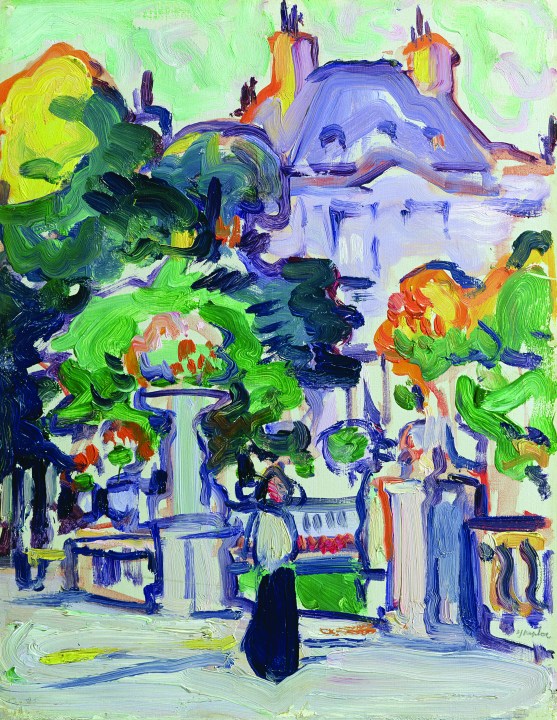This exhibition is awash with luscious brushstrokes, but then that’s to be expected: it’s full of Scottish painting. Before the barren era of conceptual art, which most hope is over, people often observed that the Scots could paint while the English could draw. Why is a bit of mystery, but it was true right through the 18th and 19th centuries and well into the 20th.
The Dovecot Studios exhibition opens with John Duncan Fergusson’s portrait of his lover and first muse, Jean Maconochie, painted about 1902. It’s a fabulous eyeful of brush marks. Her pale pink, oval face nestles under her black billowing locks, flanked by two glowing pearls dropping from her ears, the whole moony ensemble bathed in the deep green of her hat, scarf and coat as if she was emerging, miraculously, from a dark, verdant night. But what takes your breath away are the brush marks that swim through this surrounding darkness and then become finer as they shape – a better word would be stroke – her cheeks, chin, nose and the arch of her brows above rounded eyes, caresses that culminate in her pouting lips that are held aloof but at the same time appear ready to be kissed. This is painting, brush-bending, as a hymn to flesh on bone, love-making lifted out of time.
The second painting in this show, however, is an oddity. It’s ‘Self-portrait in a Turban’ (1910) by Duncan Grant who, though a Scot, had nothing to do with the Scottish colourists. Nor is it painterly, but rather drawn and dry in technique. Grant worked in London, and was a member of the Bloomsbury Group. What the painting is really about is anyone’s guess. He has depicted himself, or rather his top half, naked, wearing only a turban, which could just as easily be a bath towel, that echoes the colour of his pale blue eyes. His right hand is held aloft in a fay, come-hither gesture, as if inviting the spectator to strip and join him in his Turkish bath. Looking at this picture I couldn’t resist remembering the nickname given to him later by his intimates in the Bloomsbury Group: Drunk-And-Can’t. Why ever was this included in the show?
The exhibition is promoted as being a ‘first time showcase of the Scottish Colourists in the context of their European contemporaries’. I was looking forward to seeing how well the paintings of the four Scottish colourists, Fergusson, Peploe, Hunter and Cadell, held up beside the works of Van Gogh, Cézanne, Matisse and Derain. There is a fine Derain, but only one scrappy, utterly untypical pen-and-ink study by Matisse, and no Van Gogh nor Cézanne. But there are a host of works by the largely English Bloomsbury and Fitzroy Street groups and a sprinkling of Welsh and Irish artists, which makes the exhibition international in a way (if you’re a Scottish nationalist). Hence, perhaps, the prominence of Duncan Grant at the entrance – a Scot who emigrated to the South. All the artists included were influenced by the explosion of post-impressionism in France – but the results of their efforts were very different and these tend to cloud the distinct achievements of the four Scottish colourists themselves.
Nevertheless, oil painting, when done as well as this, is wonderful to witness. Loaded brush marks, as they dip, run, shift and lift, follow the flow of the painter’s vision. As you look at these paintings you can see the artists seeing, join them, as it were, behind their eyes. Cadell, the youngest of the four, emerges as the finest talent. His portrait of the boxer, ‘Basher Willie’ Thompson, sitting naked on a bright vermillion chair, his weathered, roseate face and hands in startling contrast to his white, usually covered flesh.
The exhibition begins with the Scottish colourists’ dark early, Edwardian still-lives – glints of light on silver sugar bowls and flowers in a vase – then moves on to their French-inspired works, tumbles of oranges, crumpled bright fabrics and bottles of red wine, but it ends with their late paintings of the Scottish landscape, above all the turquoise-green seas, rose-tinted beaches and blue mountains of the Hebridean islands. These are the most light-filled, colour-saturated and uplifting paintings in the show. One has to wonder how these artists might have fared if they’d never left home. The rare, luminous, ever-changing beauty of their native landscape could have become synonymous with the Scottish colourists. But as it is their works remain, for the most part, just one more, albeit bright, eddy on the edges of post-impressionism.








Comments